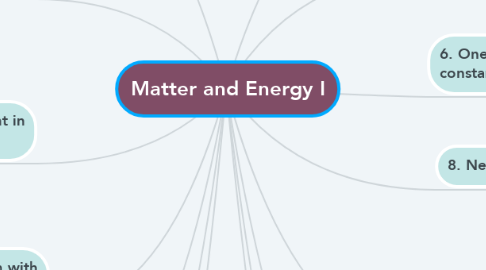
1. 3. Scalar and Vector Quantities
1.1. Some quantities can be described only by its number and a unit. This kind of quantities are called scalar. A vector is the graphical representation of a vector quantity. It is represented by an arrow where its length points out the magnitude and the tip shows the direction.
1.1.1. Formulas: x=r cos θ y= r sin θ r= √(x^2+y^2 ) θ=tan^(-1) (y/x)
2. 1. History of Physics
2.1. Physics is the science that researches the fundamental concepts of matter, energy and space, and the relationships among them. Physics is one of the oldest sciences, man has had the necessity to understand and explain all the natural phenomena that surrounds him.
2.1.1. There are two big branches: • Classic physics: Deals with small velocities compared with light speed. • Modern physics: It deals with velocities near light speed.
3. 5. Descripción of movement in one direction
3.1. Acceleration is the rate of change of velocity per unit of time. It is a vector quantity.
3.1.1. Formulas: V=d/t a=(vf-vo)/t vf=vo+at d=vot+at^2/2 vf^2=vo^2+2ad
4. 7. Two dimensional motion with constant acceleration
4.1. A projectile is a particle that moves near the Earth’s surface only by its weight. The first data given to us of a projectile launched from the ground is its initial velocity next to its launch angle. Thus, this initial velocity is a vector quantity.
4.1.1. Formulas Vox=vo cos θ Voy= vo sin θ vox=d/t vfy=voy+gt h=voyt+gt^2/2 vfy^2=voy^2+2gh
5. 9. Graphical, qualitative and quantitative description of forces
5.1. When two surfaces are in contact, the friction force oppose motion. There are two kinds of friction: • Static friction: Without relative motion. • Kinetic friction: With relative motion.
5.1.1. Formulas: F-fr=ma Fr=N μ
6. 11. Mechanical Work and Kinetic Energy
6.1. Work is a scalar quantity Formula: W=Fd The unit for work is the Joule (J)
6.2. Kinetic energy is the capability of doing work with motion Formula: Ek=mv^2/2
6.3. Power is the rate of work. Formula: P=Work/t
7. 13. Kinematics of Rotational Motion
7.1. Period: is the time that it takes to do a complete turn (rev) Frequency: Is the number of turns over time.
7.1.1. Formulas: 360° = 2π rad = 1 rev α=(wf-wo)/t wf=wo+αt θ=wot+αt^2/2 wf^2=wo^2+2αθ
7.1.2. Counterclockwise + Clockwise -
8. 10. Applications of Newton’s Laws
8.1. A free-body diagram is a diagram showing the forces acting on an object, where the direction of the forces depends on the characteristics of the type of forces applied, the free body diagram is drawn, indicating only the force vectors, emitted from the origin of the Cartesian plane, the origin representing the object or point in question.
9. 2. Measurements and Units
9.1. Measuring is a process that consists in comparing an unknown magnitude with another already known in the same unit of measure.
9.1.1. There’s direct and indirect measurement.
9.1.1.1. And there are four types of errors in direct measurement: Systematic, Random, Absolute and Relative error
10. 4. Operations with vectors
10.1. The result of a vector sum is known as resultant vector. There are two methods to sum vectors graphically: • Parallelogram method: only works for two vectors. • Tail-to-tip method: works for two or more vectors. Formulas from topic 3 are used.
11. 6. One dimensional motion with constant acceleration
11.1. Every object on Earth undergoes a common force: the force due to gravity (9.81m/s^2). So, all objects fall with the same acceleration
11.1.1. Formulas for free fall: vf=vo+gt h=vot+gt^2/2 vf^2=vo^2+2gh
12. 8. Newton’s Laws is motion
12.1. 1st law: Inertia, in the absence of external forces the state of a body won’t change. 2nd law: Law of motion, F=ma, W=mg 3rd law: For every action there’s a reaction equal but in an opposite direction.
13. 12. Potential energy and the principle of Conservation of Mechanical Energy
13.1. Potential energy is the capability of doing work given a position or condition Formula: Ep=mgh
13.2. Energy cannot be created or destroyed, only transformed. E= U+ K = Constant
14. 14. Rotational Motion dynamics
14.1. The torque is defined as the tendency to produce change in the rotational motion. Counterclockwise torque is positive and clockwise torque is negative.
14.1.1. Formulas: Τ=Iα At an end: mL^2/3 At center: mL^2/12 Ring: I=mr^2 Disk: I= mr^2/2 Sphere: I= 2/5 mr^2
15. 15. Equilibrium for Non-punctual Bodies
15.1. The equilibrium can be stable, when the object is at rest is called static equilibrium. The equilibrium is unstable when the object moves at constant speed, called dynamic equilibrium. In both cases, the acceleration is zero.
15.1.1. Condition for static equilibrium: ΣFx=0 & ΣFy=0
15.1.2. Condition for rotational equilibrium: ΣΤ=0
